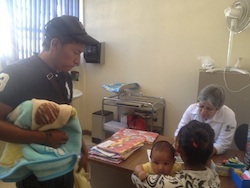In 2003, half of Mexico’s 100 million people lacked health insurance. Self-employed farmers, street vendors and those with odd jobs had to pay out of pocket for medical care. But that year, Mexico joined the other industrialized nations (besides the U.S.) by making the ideological shift from health insurance as a benefit of employment to a right of citizenship. It passed a law — with funding — to establish universal health care coverage.
Like our Affordable Care Act, the law designed primary care as the foundation of the health care system with a strong focus on prevention. In just one decade, Mexico achieved the stunning feat of enrolling some 52.6 million people into the Seguro Popular program. With universal insurance coverage a fait accompli, the country’s health care indices dramatically improved.
The number of conditions treated under Mexican public health insurance nearly quintupled, according to an August 2012 article in the Lancet, a British medical journal. Life expectancy increased. Children with leukemia have been cured. Elderly citizens get cataract operations. Women are covered for prenatal care, childbirth and breast cancer treatment. People with HIV are ensured their drugs.

Enrollees of the Seguro Popular program receive respectful, high-quality care at the Centro de Salud in Querétaro, Mexico. About 52.6 million Mexicans are enrolled in the program.
Malaria rates have dropped by 60 percent while tuberculosis mortality fell by 30 percent. Infant mortality dropped from 18.2 to 14.1 deaths per 1,000 live births, while the mortality rate of children younger than 5 fell from 28.5 to 16.8 percent. Maternal mortality numbers plummeted from 82 to 50 deaths per 100,000 live births. The fertility rate dropped to near replacement level.
In June, while on a weeklong Spanish immersion trip for health care professionals, I witnessed firsthand an example of Mexico’s robust public primary care system. We visited the state of Querétaro’s largest community health clinic — el Centro de Salud Dr. Pedro Escobedo.
In this large, simple clinic, the respect for each and every patient was palpable. It was spotlessly clean, quiet, organized and offered the Holy Grail of public health clinics: one-stop shopping. At this one site, eligibility for service is determined and patients receive primary and preventative care as well as their medications.
The medical director of the clinic, Dr. José Luís Guerrero Ortiz, explained that regular preventative checkups are compulsory for Seguro Popular beneficiaries, which encourages investment into their own health maintenance. Serving upward of 40,000 patients, the clinic offers emergency, psychology, nutrition and dental services. It’s open from 8 a.m. to 8 p.m., 365 days a year.
I met Dr. Salvador Jiménez del Prado, a former emergency room physician who sees 26 patients in 12 hours. He showed me the clinic’s small laboratory, three dental chairs, pharmacy and the ultrasound and colposcopy machines. My eyes widened and jaw dropped at the impressive list of prevention services: mammography, cervical cancer screening, a complete immunization package of 12 vaccines including those for rotavirus, pneumococcus and human papillomavirus. “We are poor. We have to prevent disease.” he said.
Despite Mexico’s praiseworthy community clinic system, care is still tiered. Only Mexican residents with private medical insurance — mostly foreigners and wealthy or upper middle-class Mexicans — have access to specialty hospitals, such as those in Guadalajara, Mexico City and Monterrey, the latter experiencing a boom in medical tourism from U.S. citizens. As many as a million U.S. retirees live in Mexico. They’re attracted to the serenity, the beauty and the low-cost, high-quality health care.
Mexico has shown that it’s possible to enroll 50 million people into health coverage within a decade. And it’s demonstrated how having insurance tremendously improves health. I wonder if 10 years from now Americans can say we successfully enrolled our 50 million uninsured into coverage. If we do, you can bet we’ll have a far healthier populace.

 Austin, Texas
Austin, Texas